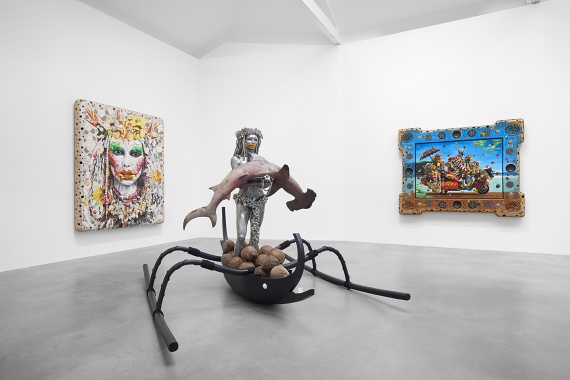
‘Ornamental Hysteria’ spans more than three decades of Bickerton’s career and features 51 works, including a significant display of new and previously unexhibited pieces. It is the artist’s first UK show since 2009 and runs throughout all six spaces at Newport Street Gallery.

Bickerton moved to New York in 1982 and after working as a painting assistant to Jack Goldstein, he emerged as a key figure on the newly exploding East Village art scene. Within the context of the culture of commodification sweeping America he rose to prominence as part of an amorphous movement that was branded ‘Neo-Geometric Conceptualism’. Alongside artists such as Haim Steinbach and Jeff Koons, Bickerton endeavoured to reframe the practice of art production in response to the new, seductive mechanisms of desire at work in society.

Bickerton abandoned New York in 1993, eventually settling in Bali, where he still lives and works. Whilst a number of his themes prevailed, the materiality of his work shifted dramatically after this self-imposed exile from the urban environment.
Both in materiality and content, Bickerton’s work resists categorisation. On the diversity of his mediums – photocollage, appropriated image, digital image, paint and sculpture – he states: “Painting is far too cartoony and lacks the backbone of factuality; photography is too clinical and incapable of loony launches into the ether; and sculpture can be just downright presumptuous. […] Only in their combination do I find comfort.”

Bickerton’s conceptual commitment to intersectionality extends to his subject matter; his audacious and technically complex assemblages are predicated on themes of opposition and duality, for example representation and reality, creativity and commodity, nature and artifice, idyll and apocalypse. This is evident in his earlier work on display in gallery 1, which offers a sardonic critique of contemporary consumer culture and the commodification of the ‘art object’ via steel and aluminium wall-mounted ‘Culturescapes’ from the ‘Logo’ and ‘Non-Word Word’ series. Galleries 3 and 4 are dominated by Bickerton’s ‘Sea’ and ‘Landscapes’ – overblown and incongruous, they contain ephemera from the anthroposphere in the simulated shells of transportation devices. In part, these “truly contemporary” landscapes might be read as a dystopian view of the devastating impact of man on the ecosphere.
Throughout his career, Bickerton has challenged the relevancy of traditional art-historical tropes. His ‘self-portraits’ similarly parody the mythological figure of ‘the artist’, who is represented in the guise of the brands he chooses to endorse in Tormented Self-Portrait: Susie at Arles (25 Years) (2014) and as a five-bodied, technicoloured serpent in the monumental 5 Snake Heads (2009), on display in Newport Street’s double-height gallery 2.

Bickerton’s practice evolved in the late 90s to incorporate digital image and photography. In portraits such as Smiling Woman (2009), models (often family members and friends) are heavily made-up and photographed, then distorted in Photoshop before the image is printed on canvas and re-painted. These paintings are amongst Bickerton’s most overtly satirical, presenting lurid, constructed visions of life on a generic Pacific / Caribbean island.
The last gallery features a display of Bickerton’s new work, including Double Manta II (White) (2017), a more elegiac counterpart to the resin sharks, obfuscated by materials and accoutrements, on display in gallery 2.Unusually for an artist whose work shifted so dramatically after his move to Bali, Bickerton has revisited one of his most important early series – ‘Wall-Wall’ – for this exhibition. The ‘Wall-Wall’ paintings feature painted surfaces interrupted by irregular fibreglass protrusions, simulating rocks. Conceived in 1986, Bickerton cites their central importance to his understanding of both the act and object of painting: how it functions and creates meaning in a world oversaturated with imagery. In essence, he explains, they are: “something that fills a space on a wall with colour that affects meaning – a surrogate wall so you’re not looking at the blankness.”
Ashley Bickerton: Ornamental Hysteria at Newport Street Gallery
Tuesday – Sunday
10am – 6pm
Closed Monday
Writing via press release
Photographs provided by the gallery
